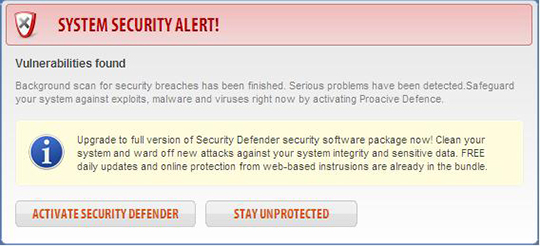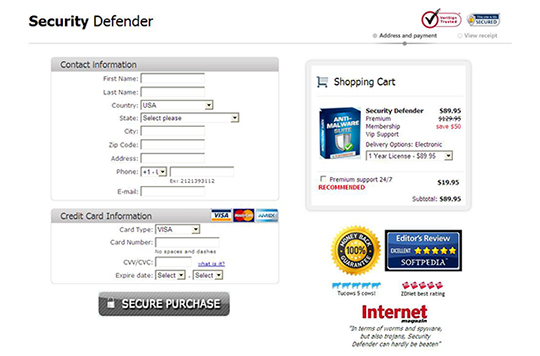TROJ_FAKEAV.BUTH
Rogue:Win32/FakeDef (Microsoft), Win32/Adware.PCDefenderPlus.A (NOD32)
Windows 2000, Windows XP (32-bit and 64-bit), Windows Server 2003, Windows Vista (32-bit and 64-bit), Windows 7 (32-bit and 64-bit)


Threat Type: Trojan
Destructiveness: No
Encrypted: No
In the wild: Yes
OVERVIEW
Downloaded from the Internet, Dropped by other malware
This Trojan may be dropped by other malware.
It does not have any propagation routine.
It does not have any backdoor routine.
When users agree to buy the software, it connects to a certain URL. It displays fake alerts that warn users of infection. It also displays fake scanning results of the affected system. It then asks for users to purchase it once scanning is completed. If users decide to purchase the rogue product, users are directed to a website asking for sensitive information, such as credit card numbers. It displays a window where users can purchase this fake antivirus program.
TECHNICAL DETAILS
1,183,712 bytes
EXE
No
18 Jan 2013
Terminates processes, Connects to URLs/IPs, Displays fake alerts
Arrival Details
This Trojan may be dropped by the following malware:
- TROJ_DLOADR.BUTH
Installation
This Trojan drops the following file(s)/component(s):
- {All Users' Profile}\Application Data\pcdfdata\app.ico
- {All Users' Profile}\Application Data\pcdfdata\defs.bin - contains downloaded malware information
- {All Users' Profile}\Application Data\pcdfdata\support.ico
- {All Users' Profile}\Application Data\pcdfdata\uninst.ico
- %Desktop%\Security Defender.lnk
- %Start Menu%\Programs\Security Defender\Remove Security Defender.lnk
- %Start Menu%\Programs\Security Defender\Security Defender Help and Support.lnk
- %Start Menu%\Programs\Security Defender\Security Defender.lnk
(Note: %Desktop% is the current user's desktop, which is usually C:\Documents and Settings\{User Name}\Desktop on Windows 2000, XP, and Server 2003, or C:\Users\{user name}\Desktop on Windows Vista and 7.. %Start Menu% is the current user's Start Menu folder, which is usually C:\Windows\Start Menu or C:\Documents and Settings\{User name}\Start Menu on Windows 2000, XP, and Server 2003, or C:\Users\{user name}\AppData\Roaming\Microsoft\Windows\Start Menu on Windows Vista and 7.)
It creates the following folders:
- %Start Menu%\Programs\Security Defender
(Note: %Start Menu% is the current user's Start Menu folder, which is usually C:\Windows\Start Menu or C:\Documents and Settings\{User name}\Start Menu on Windows 2000, XP, and Server 2003, or C:\Users\{user name}\AppData\Roaming\Microsoft\Windows\Start Menu on Windows Vista and 7.)
It adds the following mutexes to ensure that only one of its copies runs at any one time:
- Global\wdshield
Autostart Technique
This Trojan adds the following registry entries to enable its automatic execution at every system startup:
HKEY_CURRENT_USER\Software\Microsoft\
Windows\CurrentVersion\Run
pcdfsvc = "{All Users' Profile}\Application Data\pcdfdata\{TROJ_DLOADR.BUTH file name}.exe /min"
Other System Modifications
This Trojan adds the following registry keys:
HKEY_LOCAL_MACHINE\SOFTWARE\Microsoft\
Windows\CurrentVersion\Uninstall\
pcdfdata
HKEY_CLASSES_ROOT\.exe\DefaultIcon
HKEY_CLASSES_ROOT\.exe\shell
HKEY_CLASSES_ROOT\.exe\shell\
open
HKEY_CLASSES_ROOT\.exe\shell\
open\command
HKEY_CLASSES_ROOT\.exe\shell\
runas
HKEY_CLASSES_ROOT\.exe\shell\
runas\command
HKEY_CURRENT_USER\Software\Classes\
.exe
HKEY_CURRENT_USER\Software\Classes\
.exe\shell
HKEY_CURRENT_USER\Software\Classes\
.exe\shell\open
HKEY_CURRENT_USER\Software\Classes\
.exe\shell\open\
command
HKEY_CURRENT_USER\Software\Classes\
.exe\shell\runas
HKEY_CURRENT_USER\Software\Classes\
.exe\shell\runas\
command
It adds the following registry entries:
HKEY_CLASSES_ROOT\.exe\DefaultIcon
{Default} = "%1"
HKEY_CLASSES_ROOT\.exe\shell\
open\command
{Default} = ""{All Users' Profile}\Application Data\pcdfdata\{TROJ_DLOADR.BUTH file name}.exe" /ex "%1" %*"
HKEY_CLASSES_ROOT\.exe\shell\
open\command
IsolatedCommand = ""%1" %*"
HKEY_CLASSES_ROOT\.exe\shell\
runas\command
{Default} = ""%1" %*"
HKEY_CLASSES_ROOT\.exe\shell\
runas\command
IsolatedCommand = ""%1" %*"
HKEY_CURRENT_USER\Software\Classes\
.exe
{Default} = "4g"
HKEY_CURRENT_USER\Software\Classes\
.exe Content
Type = "application/x-m"
HKEY_CURRENT_USER\Software\Classes\
.exe\DefaultIcon
{Default} = "%1"
HKEY_CURRENT_USER\Software\Classes\
.exe\shell\open\
command
{Default} = ""{All Users' Profile}\Application Data\pcdfdata\{TROJ_DLOADR.BUTH file name}.exe" /ex "%1" %*"
HKEY_CURRENT_USER\Software\Classes\
.exe\shell\open\
command
IsolatedCommand = ""%1" %*"
HKEY_CURRENT_USER\Software\Classes\
.exe\shell\runas\
command
{Default} = ""%1" %*"
HKEY_CURRENT_USER\Software\Classes\
.exe\shell\runas\
command
IsolatedCommand = ""%1" %*"
HKEY_LOCAL_MACHINE\SOFTWARE\Microsoft\
Windows\CurrentVersion\Uninstall\
pcdfdata
DisplayName = "Security Defender"
HKEY_LOCAL_MACHINE\SOFTWARE\Microsoft\
Windows\CurrentVersion\Uninstall\
pcdfdata
InstallLocation = "{All Users' Profile}\Application Data\pcdfdata"
HKEY_LOCAL_MACHINE\SOFTWARE\Microsoft\
Windows\CurrentVersion\Uninstall\
pcdfdata
UninstallString = "{All Users' Profile}\Application Data\pcdfdata\{TROJ_DLOADR.BUTH file name}.exe /tout"
HKEY_LOCAL_MACHINE\SOFTWARE\Microsoft\
Windows\CurrentVersion\Uninstall\
pcdfdata
DisplayIcon = "{All Users' Profile}\Application Data\pcdfdata\{TROJ_DLOADR.BUTH file name}.exe,0"
It modifies the following registry entries:
HKEY_CLASSES_ROOT\.exe
{Default} = "4g"
(Note: The default value data of the said registry entry is exefile.)
HKEY_CLASSES_ROOT\.exe
Content Type = "application/x-m"
(Note: The default value data of the said registry entry is application/x-msdownload.)
Propagation
This Trojan does not have any propagation routine.
Backdoor Routine
This Trojan does not have any backdoor routine.
Rogue Antivirus Routine
This Trojan displays the following fake alerts:
When users agree to buy the software, it connects to the following URL to continue the purchase:
- https://{BLOCKED}.{BLOCKED}ng.com/billing/key/?uid={value}
It displays fake alerts that warn users of infection. It also displays fake scanning results of the affected system. It then asks for users to purchase it once scanning is completed. If users decide to purchase the rogue product, users are directed to the following website asking for sensitive information, such as credit card numbers:
- https://{BLOCKED}.{BLOCKED}ng.com/html/billing/?uid={value}
The following window is displayed for users to purchase the fake antivirus program:
It displays the following window and pretends to scan the system:
NOTES:
This Trojan connects to the following URL to let the remote user know that the download was successful:
- http://{BLOCKED}ologyipadinitiating.org/api/ping?stage={number}&uid={random values}
It connects to the following URL to let the remote user know that TROJ_FAKEAV.BUTH has been successfully executed:
- http://{BLOCKED}ologyipadinitiating.org/postload2/?uid={random values}
It connects to the URL to get updated list of virus information:
- http://{BLOCKED}ologyipadinitiating.org/html/viruslist/?uid={random values}
However, the said sites are inaccessible during time of analysis.
It does not have rootkit capabilities.
It does not exploit any vulnerability.
SOLUTION
9.300
9.664.01
18 Jan 2013
9.665.00
19 Jan 2013
Step 1
Before doing any scans, Windows XP, Windows Vista, and Windows 7 users must disable System Restore to allow full scanning of their computers.
Step 2
Remove the malware/grayware file that dropped/downloaded TROJ_FAKEAV.BUTH
- TROJ_DLOADR.BUTH
Step 3
Scan your computer with your Trend Micro product and note files detected as TROJ_FAKEAV.BUTH
Step 4
Restart in Safe Mode
Step 5
Delete this registry value
Important: Editing the Windows Registry incorrectly can lead to irreversible system malfunction. Please do this step only if you know how or you can ask assistance from your system administrator. Else, check this Microsoft article first before modifying your computer's registry.
- In HKEY_CURRENT_USER\Software\Microsoft\Windows\CurrentVersion\Run
- pcdfsvc = "{All Users' Profile}\Application Data\pcdfdata\{TROJ_DLOADR.BUTH file name}.exe /min"
- pcdfsvc = "{All Users' Profile}\Application Data\pcdfdata\{TROJ_DLOADR.BUTH file name}.exe /min"
Step 6
Delete this registry key
Important: Editing the Windows Registry incorrectly can lead to irreversible system malfunction. Please do this step only if you know how or you can ask assistance from your system administrator. Else, check this Microsoft article first before modifying your computer's registry.
- In HKEY_LOCAL_MACHINE\SOFTWARE\Microsoft\Windows\CurrentVersion\Uninstall
- pcdfdata
- pcdfdata
- In HKEY_CLASSES_ROOT\.exe
- DefaultIcon
- DefaultIcon
- In HKEY_CLASSES_ROOT\.exe
- shell
- shell
- In HKEY_CURRENT_USER\Software\Classes
- .exe
- .exe
Step 7
Restore this modified registry value
Important: Editing the Windows Registry incorrectly can lead to irreversible system malfunction. Please do this step only if you know how or you can ask assistance from your system administrator. Else, check this Microsoft article first before modifying your computer's registry.
- In HKEY_CLASSES_ROOT\.exe
- From: {Default} = "4g"
To: {Default} = "exefile"
- From: {Default} = "4g"
- In HKEY_CLASSES_ROOT\.exe
- From: Content Type = "application/x-m"
To: Content Type = "application/x-msdownload"
- From: Content Type = "application/x-m"
Step 8
Search and delete this file
- %Desktop%\Security Defender.lnk
Step 9
Search and delete these folders
- {All Users' Profile}\Application Data\pcdfdata
- %Start Menu%\Programs\Security Defender
Step 10
Restart in normal mode and scan your computer with your Trend Micro product for files detected as TROJ_FAKEAV.BUTH. If the detected files have already been cleaned, deleted, or quarantined by your Trend Micro product, no further step is required. You may opt to simply delete the quarantined files. Please check this Knowledge Base page for more information.
Did this description help? Tell us how we did.




